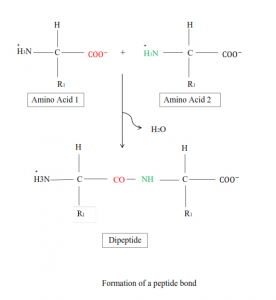Protein Structure
A protein is a linear sequence of amino acids linked together by peptide bonds. The peptide bond is a covalent bond between the α-amino group of one amino acid and the α-carboxyl group of another.
Levels of Protein Structure
Protein structures can be classified into four levels:
- Primary Structure
- Secondary Structure
- Tertiary Structure
- Quaternary Structure
- Primary Structure
The linear sequence of amino acids joined together by peptide bond is termed as the primary structure of the protein. When the amino group of an amino acid combines with the carboxyl group of another amino acid, a peptide bond is formed.
- Secondary Structure
The secondary structure of protein refers to a three dimensional arrangement of various atoms of the molecules, generally known as protein conformation. An important characteristic of secondary structure is the formation of hydrogen bonds (H bonds) between the –CO group of one peptide bond and the –NH group of another nearby peptide bond. If the H bonds form between peptide bonds in the same chain, either helical structure, such as the α-helix, develop or turns, such as β-turns are formed. If H bonds form between peptide bonds in different chains, extended structures form, such as the β-pleated sheet.
- Tertiary Structure
The three dimensional arrangement of protein structure is referred to as tertiary structure. It is a compact structure with hydrophobic side chains held interior while the hydrophilic groups are on the surface of the protein molecule. This type of arrangement ensures stability of the molecule.
Besides the hydrogen bonds, disulphile bonds, ionic interactions, hydrophobic interactions and van der Waals forces also contribute to the tertiary structure of proteins. Myoglobin is the first protein whose tertiary structure was established.
- Quaternary Structure
It refers to the structure and interactions of the noncovalent association of discrete polypeptide subunits into a multisubunit protein. The monomeric subunits are held together by non-covalent bonds namely hydrogen bonds, hydrophobic interactions and ionic bonds.


